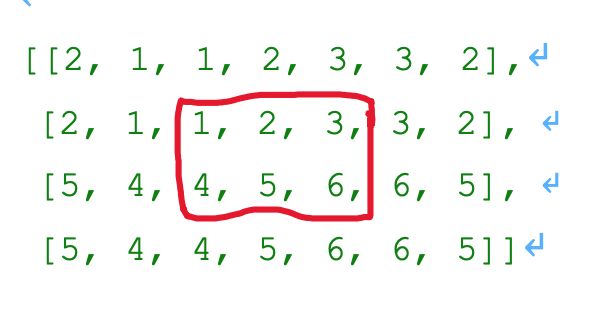函数:
tf.compat.v1.padtf.pad
函数表达式如下:
tf.pad(
tensor,
paddings,
mode='CONSTANT',
name=None,
constant_values=0
)
函数用途:对各个维度进行填充,padding
输入:
- tensor :是要填充的张量; shape 维度为 : (N1,N2,N3,...);
- padings:填充方式,也是一个张量,shape : (n,2), n :表示需要的pad的tensor的维度个数;
- mode:有三种取值:分别是"CONSTANT" ,"REFLECT", "SYMMETRIC",对padding 的维度也有限制,如下padded;
- mode="CONSTANT" 是直接填充 constant_values;
- mode = "REFLECT" 是轴对称填充(对称轴为边界列),此时constant_values 无效,用tensor 中的值填充;
- mode = "SYMMETRIC" 是轴对称填充(对称轴为边界线),此时 constant_values 无效,用tensor 中的值填充;
- constant_values:要填充的 value 值,默认为0;
padding shape举个例子:
要求:pad 维度为(n,2) n:为tensor 的维度个数;
第一组:
input tensor,shape【3,4,5】三维 tensor
padding shape:【3,2】
第二组:
input tensor,shape【3,4,5,6】四维 tensor
padding shape:【4,2】
padding 的每一维度,都有两个数,第一个表示前面添加几维度,第二个表示 后面添加几维度;
padded 填充之后的每一维度:
The padded size of each dimension D of the output is:
paddings[D, 0] + tensor.dim_size(D) + paddings[D, 1]
if mode == "REFLECT" or mode == "SYMMETRIC":
paddings[D, 0] + paddings[D, 1] <= tensor.dim_size(D) - 1
举个例子-》填充后的tensor shape:
tensor shape : (3,5,4)
padding = [[1,1],[2,2],[1,0]]
padded shape: (3+1+1,5+2+2,4+1+0)= (5,9,5)
REFLECT:的填充方式使用的是一种通过对称轴进行对称复制的方式进行填充(复制时不包括对称轴,边界的那一列是对称轴),通过使用tensor边缘作为对称;

SYMMETRIC:的填充方式于REFLECT填充方式类似,也是按照对称轴就是复制的,只是它包括对称轴(边界外的线是对称轴)。

举例一:(来自官方):
1 t = tf.constant([[1, 2, 3], [4, 5, 6]]) #shape(2,3) 2 paddings = tf.constant([[1, 1,], [2, 2]]) # shape(2,2),第一维度,前面补一维度,后面补一维度;第二维度,前面补两维度,后面补两维度; 3 # 'constant_values' is 0. 4 # rank of 't' is 2. 5 tf.pad(t, paddings, "CONSTANT") # [[0, 0, 0, 0, 0, 0, 0], 6 # [0, 0, 1, 2, 3, 0, 0], 7 # [0, 0, 4, 5, 6, 0, 0], 8 # [0, 0, 0, 0, 0, 0, 0]] 9 10 tf.pad(t, paddings, "REFLECT") # [[6, 5, 4, 5, 6, 5, 4], 11 # [3, 2, 1, 2, 3, 2, 1], # 黄色为对称轴 12 # [6, 5, 4, 5, 6, 5, 4], 13 # [3, 2, 1, 2, 3, 2, 1]] 14 15 tf.pad(t, paddings, "SYMMETRIC") # [[2, 1, 1, 2, 3, 3, 2], 16 # [2, 1, 1, 2, 3, 3, 2], # 17 # [5, 4, 4, 5, 6, 6, 5], 18 # [5, 4, 4, 5, 6, 6, 5]]
举例二:
import tensorflow as tf import numpy as np m1 = tf.random_normal([1,2,3,4],mean=0.0,stddev=1.0,dtype=tf.float32) m2 = tf.pad(m1,[[2,0],[0,0],[0,0],[0,0]],constant_values = 1) m2_s = tf.shape(m2) # shape(3,2,3,4) with tf.Session() as sess: print(sess.run(m1)) print(sess.run(m2)) print(sess.run(m2_s))
output:

# m1 [[[[-1.8582115 -1.170714 -0.4478178 2.0172668 ] [-0.74805504 -0.08016825 -0.7742696 -0.02516617] [-0.8256318 0.591446 -0.00889379 1.7998788 ]] [[ 0.00565176 -0.31549874 1.5197186 0.07842494] [ 0.00609808 1.9219669 -0.42632174 1.5106113 ] [ 0.67241013 -0.38563538 -0.976289 0.2032768 ]]]] #m2 [[[[ 1. 1. 1. 1. ] [ 1. 1. 1. 1. ] [ 1. 1. 1. 1. ]] [[ 1. 1. 1. 1. ] [ 1. 1. 1. 1. ] [ 1. 1. 1. 1. ]]] [[[ 1. 1. 1. 1. ] [ 1. 1. 1. 1. ] [ 1. 1. 1. 1. ]] [[ 1. 1. 1. 1. ] [ 1. 1. 1. 1. ] [ 1. 1. 1. 1. ]]] [[[-1.2366703 -1.0050759 -0.3843815 1.0201392 ] [-1.3438475 0.8829414 -1.3399163 1.078826 ] [-0.09356844 0.35896888 1.5112561 0.28352356]] [[ 0.45909956 -0.23824279 -0.31440428 1.1913226 ] [-0.40780786 0.58995795 -0.9147027 0.05860058] [-0.0659609 1.4536899 -0.12121342 -0.9752257 ]]]] #output shape [3 2 3 4]
